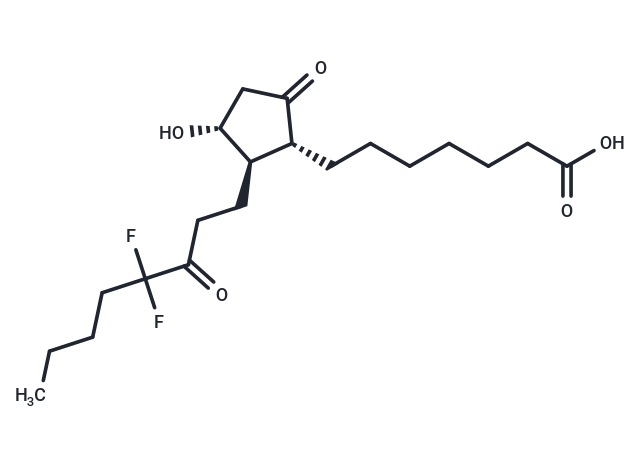Shopping Cart
- Remove All
 Your shopping cart is currently empty
Your shopping cart is currently empty

Lubiprostone (RU-0211), an activator of ClC-2 chloride channels, is used in the therapy of idiopathic chronic constipation.

| Pack Size | Price | Availability | Quantity |
|---|---|---|---|
| 5 mg | $47 | In Stock | |
| 10 mg | $77 | In Stock | |
| 25 mg | $138 | In Stock | |
| 50 mg | $227 | In Stock | |
| 100 mg | $345 | In Stock | |
| 500 mg | $825 | In Stock | |
| 1 mL x 10 mM (in DMSO) | $52 | In Stock |
| Description | Lubiprostone (RU-0211), an activator of ClC-2 chloride channels, is used in the therapy of idiopathic chronic constipation. |
| In vitro | Lubiprostone induces a robust secretory response in T84 monolayers. Lubiprostone induces a rise in cAMP levels that was sensitive to EP(4)-receptor blockage in T84 cells. [1] Lubiprostone induces a contraction in rat and human stomach longitudinal muscle, which is inhibited by pretreatment with the EP(1) receptor antagonist but not by the EP(3) or EP(4) receptor antagonists. Lubiprostone also reduces electrically stimulated, neuronal contractions in rat and human colon circular muscle preparations. [2] Lubiprostone (1 mM) stimulates higher elevations in TER despite lower I(sc) responses compared with the nonselective secretory agonist PGE(2) (1 mM). Lubiprostone significantly reduces mucosal-to-serosal fluxes of (3)H-labeled mannitol to levels comparable to those of normal control tissues and restored occludin localization to tight junctions. [3] Lubiprostone causes comparable and maximal increases of I(sc) in T84 cells. Lubiprostone-induced increases in iodide efflux are ~80% of those obtained with forskolin. Lubiprostone activates Cl(-) secretion in T84 cells via cAMP, protein kinase A, and by increasing apical membrane CFTR protein. [4] Lubiprostone, applied to the small intestinal mucosa in eight concentrations ranging from 1-3000 nM, evokes increases in Isc in a concentration-dependent manner with an EC50 of 42.5 nM. Lubiprostone applied to the mucosa of the colon in eight concentrations ranging from 1-3000 nM evokes increases in Isc in a concentration-dependent manner with an EC50 of 31.7 nM. [5] |
| In vivo | Lubiprostone induces a CdCl(2)-insensitive secretory response in mouse intestine, but fail to induce intestinal Cl(-) secretion in Cftr-null mice. [1] |
| Kinase Assay | Fluorescence polarization-based competition assay: Inhibition constants ( Ki ) for the antagonists are determined by addition of the IAP protein constructs to wells containing serial dilutions of the antagonists or the peptide AVPW, and the Hid-FAM probe or AVP-diPhe-FAM probe, as appropriate, in the polarization buffer. Samples are read after a 30-minute incubation. Fluorescence polarization values are plotted as a function of the antagonist concentration, and the IC50 values are obtained by fitting the data to a 4-parameter equation using software. Ki values for the antagonists are determined from the IC50 valued. |
| Alias | SPI-0211, RU-0211 |
| Molecular Weight | 390.46 |
| Formula | C20H32F2O5 |
| Cas No. | 136790-76-6 |
| Smiles | CCCCC(F)(F)C(=O)CC[C@H]1[C@H](O)CC(=O)[C@@H]1CCCCCCC(O)=O |
| Relative Density. | 1.175 g/cm3 |
| Storage | Powder: -20°C for 3 years | In solvent: -80°C for 1 year | Shipping with blue ice. | |||||||||||||||||||||||||||||||||||
| Solubility Information | Ethanol: 72 mg/mL (184.4 mM), Sonication is recommended. DMSO: 70 mg/mL (179.28 mM), Sonication is recommended. H2O: < 1 mg/mL (insoluble or slightly soluble) | |||||||||||||||||||||||||||||||||||
Solution Preparation Table | ||||||||||||||||||||||||||||||||||||
DMSO/Ethanol
| ||||||||||||||||||||||||||||||||||||

Copyright © 2015-2025 TargetMol Chemicals Inc. All Rights Reserved.